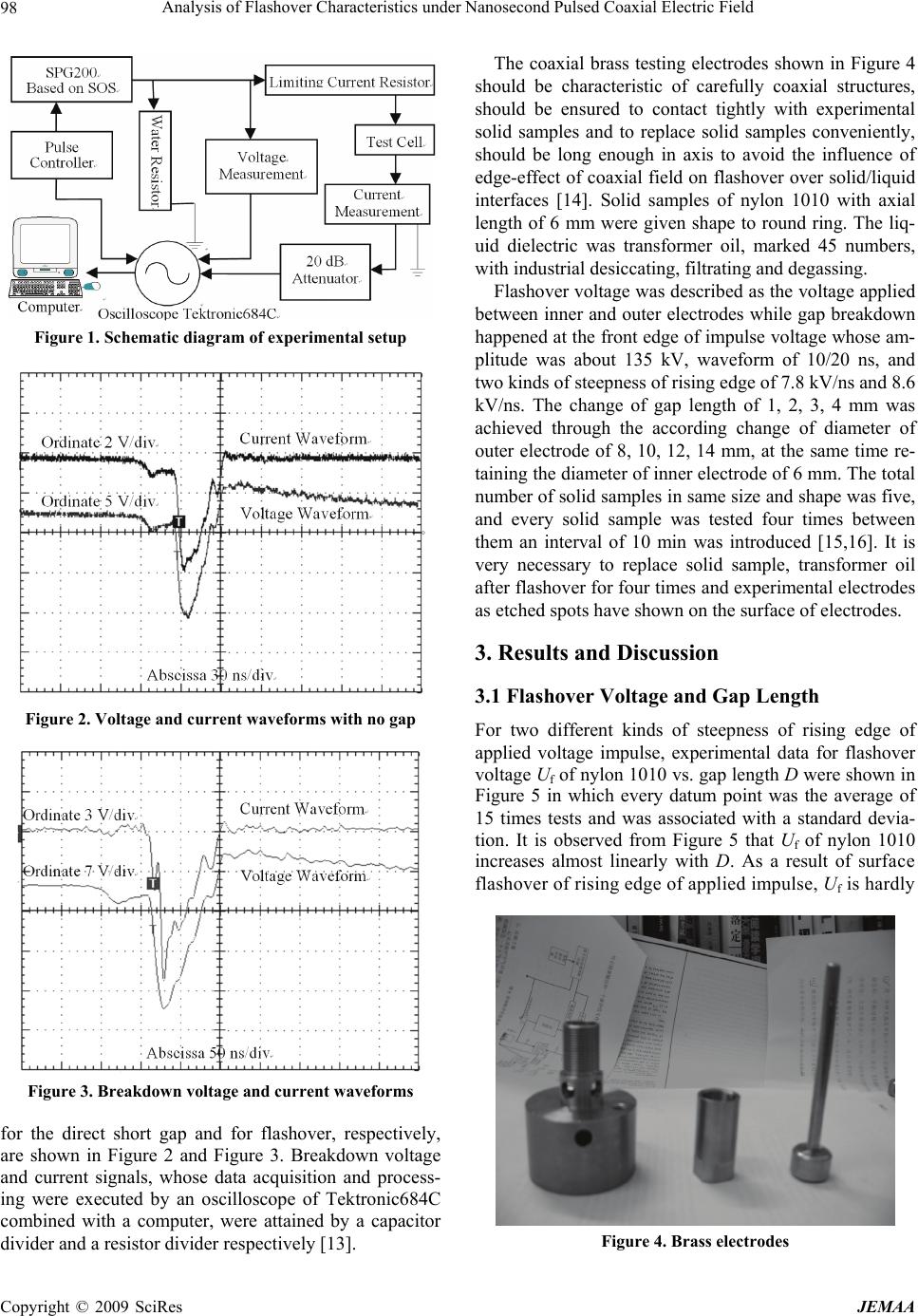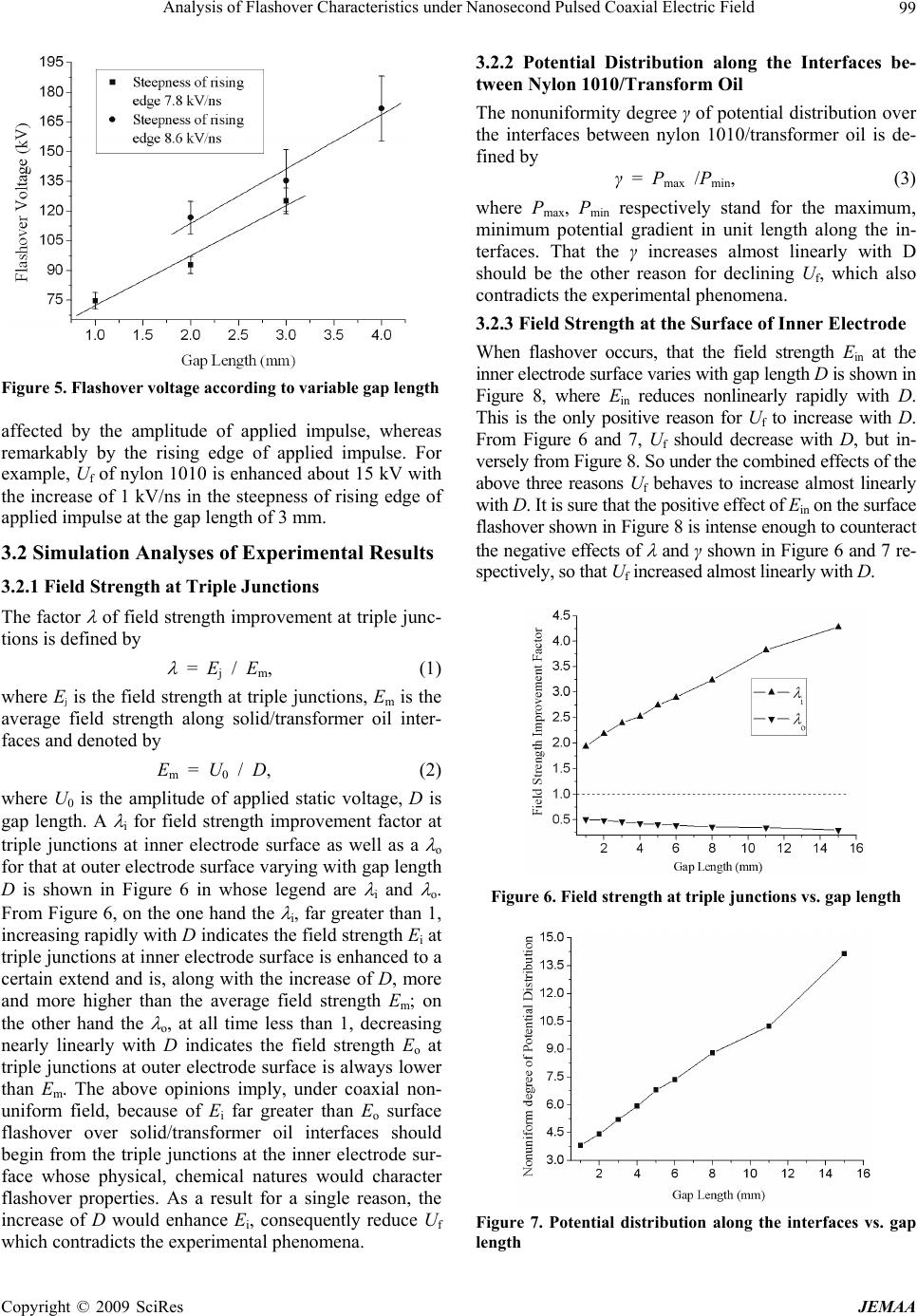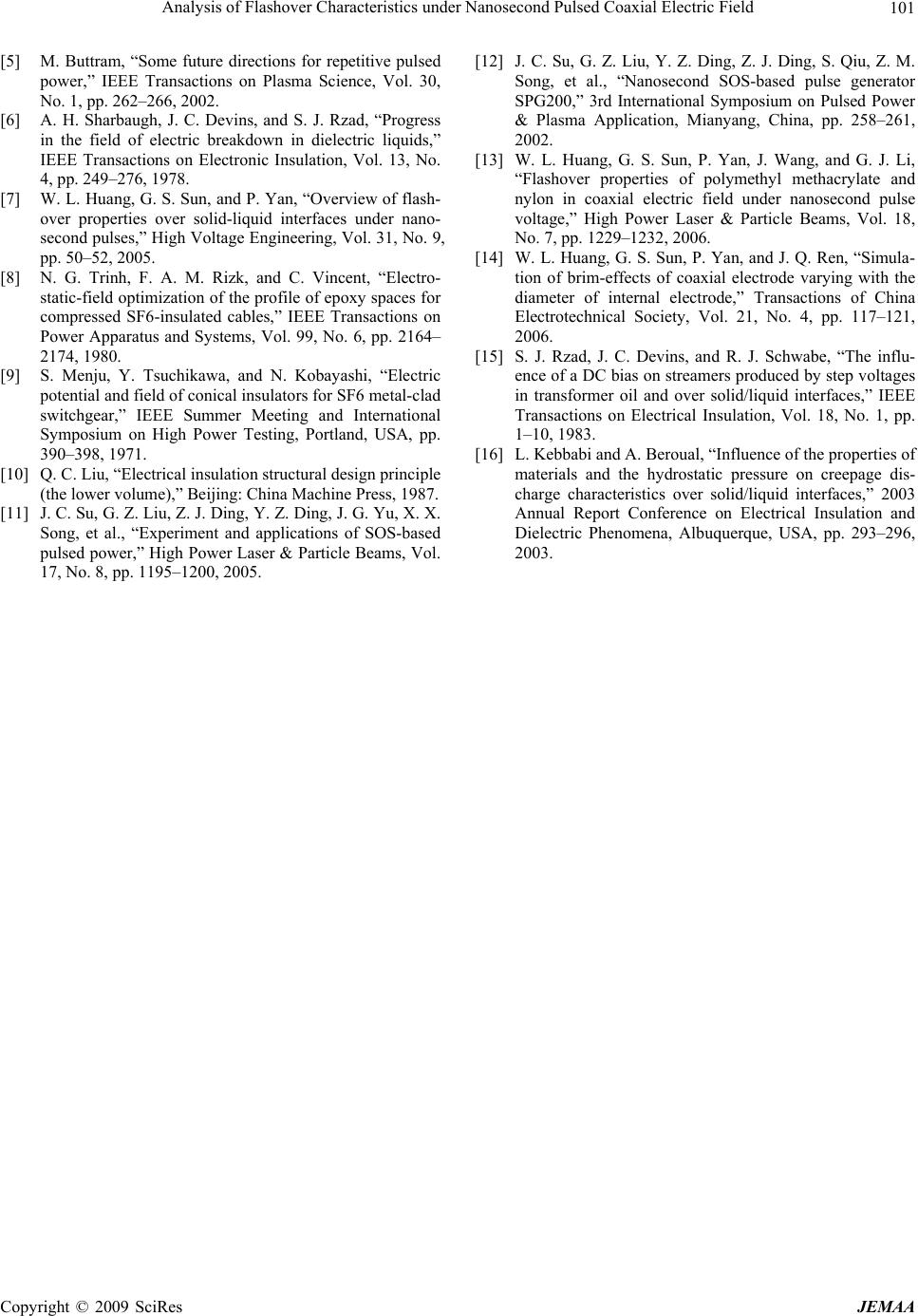 J. Electromagnetic Analysis & Applications, 2009, 2: 97-101 doi:10.4236/jemaa.2009.12015 Published Online June 2009 (www.SciRP.org/journal/jemaa) Copyright © 2009 SciRes JEMAA 1 Analysis of Flashover Characteristics under Nanosecond Pulsed Coaxial Electric Field W. L. Huang1, J. F. Cui1, G. S. Sun2 1School of Mechatronics Engineering, Zhengzhou Institute of Aeronautical Industry Management, Zhengzhou, China; 2Institute of Electrical Engineering, Chinese Academy of Sciences, Beijing, China. Email: hwl@zzia.edu.cn Received February 17th, 2009; revised March 24th, 2009; accepted April 2nd, 2009. ABSTRACT Under nanosecond pulsed coaxial electric field, surface flashover voltage over the interfaces between nylon 1010 and transformer oil increases almost linearly with gap length, and the steeper rising edge of applied pulse, the higher flash- over voltage. Surface flashover properties are closely related to the electric field at the triple junctions of solid-liquid-electrode and the field gradient along the interfaces. Although the increased difference between inner and outer electrode radii will enhance electric field strength at the triple junctions and nonuniformity degree of potential distribution along interfaces, it reduces simultaneously terribly the surface field strength of coaxial inner electrode, so that flashover voltage doesn’t descend, but ascends almost linearly with gap length. The average flashover strength in coaxial electric field can be estimated by that in uniform electric field for large enough difference between inner and outer electrode radii, which is useful to practical engineering design for coaxial pulsed power apparatuses. Keywords: Pulsed Power Technology, Coaxial Electrodes, Gap Length, Surface Flashover, Triple Junctions, Surface Potential 1. Introduction Although coaxial pulsed power apparatuses are wide- spread, researches on discharge characteristic over trans- former oil/solid interfaces under nanosecond pulsed co- axial field, as opposed to discharge characteristic over gas/solid or vacuum/solid interfaces under uniform field, are less, which can’t meet the rapid development of pulsed power technology [1-7]. Surface flashover, whether applied dc, ac or impulse voltages, are closely relevant to potential distribution gradient along interfaces between different dielectrics. Trinh [8] and Menju [9], respectively, pointed out the relationship between flash- over field strength and different parameters of coaxial experimental electrodes might be speculated on through corresponding states of potential distribution along the interfaces and field strength at triple junctions. Liu [10] plotted the varying curve of breakdown voltage vs. non- uniformity degree of electric field in electrode gap in transformer oil, discovered that breakdown voltage in uniform field was about three times higher than that in nonuniform field under applied impulse voltage of pulse-width of 40 µs, and achieved that change of uni- formity degree of electric field in gap worked on break- down voltage more prominent under impulse voltage than under ac voltage. This contribution analyzed flashover characteristic over transformer oil/nylon 1010 interfaces under coaxial nanosecond pulsed field in the case of changing radius difference between inner and outer elec- trodes from the viewpoint of potential distribution over the interfaces and field strength at triple junctions, and compared flashover properties in coaxial field with ones in uniform field, thus draw conclusions useful to studying flashover over interfaces between different dielectrics and to the developments of pulsed power technology. 2. Experimental Setup and Methods The entire structures of electric connection of experi- mental setup are shown in Figure 1. The high voltage nanosecond pulsed power supply is SPG200 based on Semiconductor Opening Switch (SOS) in Northwest In- stitute of Nuclear Technology, whose amplitude of output voltage which can reach maximum 350 kV is modulated by adjusting the resistor of cycling salt water. A resistor of 200 Ω is in series with electrode gap in order to avoid excessive current of gap breakdown impairing SPG200 [11,12]. An impulse of pulse-width of about 30 ns, rising edge of about 10 ns, is produced by SPG200. Accord- ingly, the waveforms of breakdown voltage and current  Analysis of Flashover Characteristics under Nanosecond Pulsed Coaxial Electric Field 98 Figure 1. Schematic diagram of experimental setup Figure 2. Voltage and current waveforms with no gap Figure 3. Breakdown voltage and current waveforms for the direct short gap and for flashover, respectively, are shown in Figure 2 and Figure 3. Breakdown voltage and current signals, whose data acquisition and process- ing were executed by an oscilloscope of Tektronic684C combined with a computer, were attained by a capacitor divider and a resistor divider respectively [13]. The coaxial brass testing electrodes shown in Figure 4 should be characteristic of carefully coaxial structures, should be ensured to contact tightly with experimental solid samples and to replace solid samples conveniently, should be long enough in axis to avoid the influence of edge-effect of coaxial field on flashover over solid/liquid interfaces [14]. Solid samples of nylon 1010 with axial length of 6 mm were given shape to round ring. The liq- uid dielectric was transformer oil, marked 45 numbers, with industrial desiccating, filtrating and degassing. Flashover voltage was described as the voltage applied between inner and outer electrodes while gap breakdown happened at the front edge of impulse voltage whose am- plitude was about 135 kV, waveform of 10/20 ns, and two kinds of steepness of rising edge of 7.8 kV/ns and 8.6 kV/ns. The change of gap length of 1, 2, 3, 4 mm was achieved through the according change of diameter of outer electrode of 8, 10, 12, 14 mm, at the same time re- taining the diameter of inner electrode of 6 mm. The total number of solid samples in same size and shape was five, and every solid sample was tested four times between them an interval of 10 min was introduced [15,16]. It is very necessary to replace solid sample, transformer oil after flashover for four times and experimental electrodes as etched spots have shown on the surface of electrodes. 3. Results and Discussion 3.1 Flashover Voltage and Gap Length For two different kinds of steepness of rising edge of applied voltage impulse, experimental data for flashover voltage Uf of nylon 1010 vs. gap length D were shown in Figure 5 in which every datum point was the average of 15 times tests and was associated with a standard devia- tion. It is observed from Figure 5 that Uf of nylon 1010 increases almost linearly with D. As a result of surface flashover of rising edge of applied impulse, Uf is hardly Figure 4. Brass electrodes Copyright © 2009 SciRes JEMAA  Analysis of Flashover Characteristics under Nanosecond Pulsed Coaxial Electric Field 99 Figure 5. Flashover voltage according to variable gap length affected by the amplitude of applied impulse, whereas remarkably by the rising edge of applied impulse. For example, Uf of nylon 1010 is enhanced about 15 kV with the increase of 1 kV/ns in the steepness of rising edge of applied impulse at the gap length of 3 mm. 3.2 Simulation Analyses of Experimental Results 3.2.1 Field Strength at Triple Junctions The factor of field strength improvement at triple junc- tions is defined by = Ej / Em, (1) where Ej is the field strength at triple junctions, Em is the average field strength along solid/transformer oil inter- faces and denoted by Em = U0 / D, (2) where U0 is the amplitude of applied static voltage, D is gap length. A i for field strength improvement factor at triple junctions at inner electrode surface as well as a o for that at outer electrode surface varying with gap length D is shown in Figure 6 in whose legend are i and o. From Figure 6, on the one hand the i, far greater than 1, increasing rapidly with D indicates the field strength Ei at triple junctions at inner electrode surface is enhanced to a certain extend and is, along with the increase of D, more and more higher than the average field strength Em; on the other hand the o, at all time less than 1, decreasing nearly linearly with D indicates the field strength Eo at triple junctions at outer electrode surface is always lower than Em. The above opinions imply, under coaxial non- uniform field, because of Ei far greater than Eo surface flashover over solid/transformer oil interfaces should begin from the triple junctions at the inner electrode sur- face whose physical, chemical natures would character flashover properties. As a result for a single reason, the increase of D would enhance Ei, consequently reduce Uf which contradicts the experimental phenomena. 3.2.2 Potential Distribution along the Interfaces be- tween Nylon 1010/Transform Oil The nonuniformity degree γ of potential distribution over the interfaces between nylon 1010/transformer oil is de- fined by γ = Pmax /Pmin, (3) where Pmax, Pmin respectively stand for the maximum, minimum potential gradient in unit length along the in- terfaces. That the γ increases almost linearly with D should be the other reason for declining Uf, which also contradicts the experimental phenomena. 3.2.3 Field Strength at the Surface of Inner Electrode When flashover occurs, that the field strength Ein at the inner electrode surface varies with gap length D is shown in Figure 8, where Ein reduces nonlinearly rapidly with D. This is the only positive reason for Uf to increase with D. From Figure 6 and 7, Uf should decrease with D, but in- versely from Figure 8. So under the combined effects of the above three reasons Uf behaves to increase almost linearly with D. It is sure that the positive effect of Ein on the surface flashover shown in Figure 8 is intense enough to counteract the negative effects of and γ shown in Figure 6 and 7 re- spectively, so that Uf increased almost linearly with D. Figure 6. Field strength at triple junctions vs. gap length Figure 7. Potential distribution along the interfaces vs. gap length Copyright © 2009 SciRes JEMAA  Analysis of Flashover Characteristics under Nanosecond Pulsed Coaxial Electric Field 100 Figure 8. Field strength at the inner electrode surface vs. gap length Figure 9. Flashover comparison between coaxial and uni- form field The above statement indicates , in a general way, the higher field strength at solid-liquid-electrode triple junc- tions as well as the more nonuniform potential distribu- tion over the interfaces between different dielectrics should lessen the resultant flashover voltage, however, under the actual circumstances, one should think over all sorts of factors working on flashover, otherwise would receive false results. 3.3 Comparing the Results under Coaxial Elec- tric Field with Those under Uniform Field The average flashover field strength Eav in the coaxial field was compared with that in the uniform field in Fig- ure 9. Eav equals to flashover voltage Uf divided by gap length D in the coaxial and uniform field respectively, i.e. Eav = Uf / D. (4) The Eav in the coaxial field is lower than that in the uniform field for the same solid samples, applied impulse voltage and gap length; For example, the Eav in the coax- ial field is about half of the one in the uniform field at the gap length of 1 mm. With the increase of D, the differ- ence of Eav between two types of electric fields is dimin- ished and the decline of both Eav with D is also stabilized gradually. That two curves of Eav vs. D in Figure 9 ap- proaches each other after surpassing a relatively greater gap length ( > 4 mm under this experimental conditions , for example) reveals it is sensible to speculate on flash- over voltage under coaxial field by the one under uniform field, which is valuable to the industrial designs of pulsed power equipments of coaxial structure. 4. Conclusions The flashover voltage along the interfaces between nylon 1010/transformer oil increases nearly linearly with gap length under nanosecond pulsed coaxial electric field. The composition effects of enhanced field strength at triple junctions, heightened nonuniformity degree of po- tential distribution over the interfaces between nylon 1010/ transformer oil and descended sharply field strength at the inner electrode surface make flashover voltage increase almost linearly with gap length whose increase would lead the coaxial field to tend to the very nonuniform field under point-plane electrodes. Flashover natures are closely related to the electric field strength at triple junctions of solid-liquid-electrode and the potential distribution along the interfaces between different dielectrics. It is, in a general way, sure that the higher field strength at triple junctions and the more nonuniform potential distribution along the interfaces between different dielectrics would result in the lower flashover voltage, whereas in practice one should take all kinds of factors controlling flashover into account for correct results. While gap length of coaxial electrodes is large enough, the average flashover field strength in coaxial field can be estimated by means of that in uniform field, which is rather significant to the design of coaxial structural pulsed power apparatus. 5. Acknowledgments The authors gratefully acknowledge the support and as- sistance in experiment by Room 3 and 6 in Northwest Institute of Nuclear Technology. REFERENCES [1] X. S. Liu, “High power pulsed technology,” Beijing: Na- tional Defence Industry Press, 2005. [2] Z. Z. Zeng, “An introduction to practical pulsed power technology,” Xi’an: Shanxi Science and Technology Pub- lishing House, 2003. [3] J. C. Martin, “Nanosecond pulse techniques,” Proceedings of the IEEE, Vol. 80, No. 6, pp. 934–945, 1992. [4] T. H. Martin, A. H. Guenther, and M. Kristiansen, “J. C. Martin on pulsed power,” New York: Plenum Press, 1996. Copyright © 2009 SciRes JEMAA  Analysis of Flashover Characteristics under Nanosecond Pulsed Coaxial Electric Field Copyright © 2009 SciRes JEMAA 101 [5] M. Buttram, “Some future directions for repetitive pulsed power,” IEEE Transactions on Plasma Science, Vol. 30, No. 1, pp. 262–266, 2002. [6] A. H. Sharbaugh, J. C. Devins, and S. J. Rzad, “Progress in the field of electric breakdown in dielectric liquids,” IEEE Transactions on Electronic Insulation, Vol. 13, No. 4, pp. 249–276, 1978. [7] W. L. Huang, G. S. Sun, and P. Yan, “Overview of flash- over properties over solid-liquid interfaces under nano- second pulses,” High Voltage Engineering, Vol. 31, No. 9, pp. 50–52, 2005. [8] N. G. Trinh, F. A. M. Rizk, and C. Vincent, “Electro- static-field optimization of the profile of epoxy spaces for compressed SF6-insulated cables,” IEEE Transactions on Power Apparatus and Systems, Vol. 99, No. 6, pp. 2164– 2174, 1980. [9] S. Menju, Y. Tsuchikawa, and N. Kobayashi, “Electric potential and field of conical insulators for SF6 metal-clad switchgear,” IEEE Summer Meeting and International Symposium on High Power Testing, Portland, USA, pp. 390–398, 1971. [10] Q. C. Liu, “Electrical insulation structural design principle (the lower volume),” Beijing: China Machine Press, 1987. [11] J. C. Su, G. Z. Liu, Z. J. Ding, Y. Z. Ding, J. G. Yu, X. X. Song, et al., “Experiment and applications of SOS-based pulsed power,” High Power Laser & Particle Beams, Vol. 17, No. 8, pp. 1195–1200, 2005. [12] J. C. Su, G. Z. Liu, Y. Z. Ding, Z. J. Ding, S. Qiu, Z. M. Song, et al., “Nanosecond SOS-based pulse generator SPG200,” 3rd International Symposium on Pulsed Power & Plasma Application, Mianyang, China, pp. 258–261, 2002. [13] W. L. Huang, G. S. Sun, P. Yan, J. Wang, and G. J. Li, “Flashover properties of polymethyl methacrylate and nylon in coaxial electric field under nanosecond pulse voltage,” High Power Laser & Particle Beams, Vol. 18, No. 7, pp. 1229–1232, 2006. [14] W. L. Huang, G. S. Sun, P. Yan, and J. Q. Ren, “Simula- tion of brim-effects of coaxial electrode varying with the diameter of internal electrode,” Transactions of China Electrotechnical Society, Vol. 21, No. 4, pp. 117–121, 2006. [15] S. J. Rzad, J. C. Devins, and R. J. Schwabe, “The influ- ence of a DC bias on streamers produced by step voltages in transformer oil and over solid/liquid interfaces,” IEEE Transactions on Electrical Insulation, Vol. 18, No. 1, pp. 1–10, 1983. [16] L. Kebbabi and A. Beroual, “Influence of the properties of materials and the hydrostatic pressure on creepage dis- charge characteristics over solid/liquid interfaces,” 2003 Annual Report Conference on Electrical Insulation and Dielectric Phenomena, Albuquerque, USA, pp. 293–296, 2003.
|